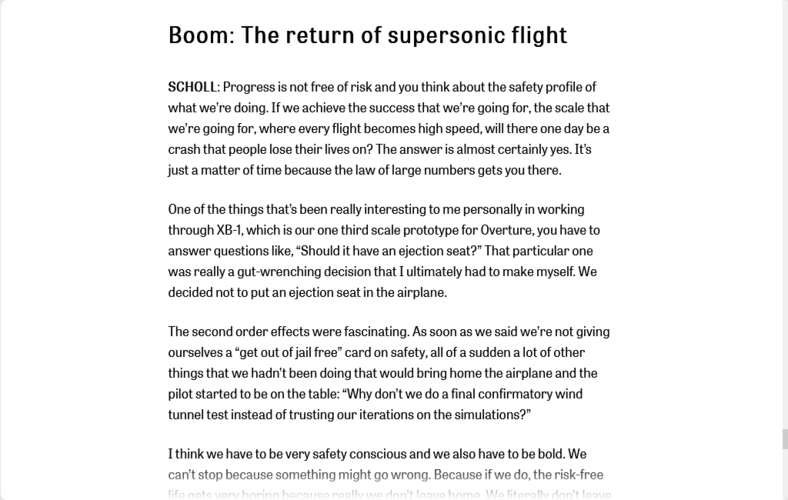martinbayer
ACCESS: Top Secret
- Joined
- 6 January 2009
- Messages
- 2,374
- Reaction score
- 2,100
Somehow I sense there is some inherent irony in tortoises impeding commercial supersonic flight trials... Perhaps Australia could help out?
At this point I think it’s just to build confidence - that the engineers know what they’re doing, that the design models work, and that they have a good experimental process in place. Any mistakes they make at this step are less serious and good learning opportunities. I guess that shouldn’t be underestimated.Its planform is different, its configuration is different, its engines are different. What is its purpose?
Titanium fires (or as we in the propulsion community call them “rapid oxidation events”) need high oxygen partial pressures and temperatures to propagate and very high temperatures to start. The rear stages of the compressor can provide the pressure / temperature conditions and a broken Ti blade rub can generate the ignition temperature.Zoo Tycoon said:
“Does anyone know if the J85 has steel LP compressor blades/staters?
I notice it was never used in any super cruise applications and typically super cruise engines will have a steel front end. This was/is because of the heat build up during sustained supersonic flight. Aluminium Alloy loses strength too quickly and Titanium has a habit of catching fire although has seen a few applications. Most supersonic aircraft such as the F5 will only be cleared for a short time at high speed measured in tens of seconds to a few single minutes. The XB1 usefulness will be significantly limited if it can’t collect sustained supersonic flight thermal flux data.
Also has anyone seen objective for time at supersonic Mach number?
Nobody has had issues with titanium fires in their engines since the 1960s, because people learned just how much stretch was happening and made the appropriate allowances for it.”
Scott Kenny replied;-
Nobody has had issues with titanium fires in their engines since the 1960s, because people learned just how much stretch was happening and made the appropriate allowances for it.
Zoo Tycoon
Ah no, Concorde entered service in 1976, and by 1980 had suffered two Ti compressor fires. So several Ti compressor stages were changed to steel. I understand the problem wasn’t blade stretch, but manufacture quality assurance. Remember that in the first five years of Concorde service the fleet, although small, achieved about 100 x the time at Mach 2 as the entire military previous experience. The grim reality associated with pioneering is a harsh mistress.
I bet those were exciting...When P&W added fan blade containment to the F-14 / TF30-P-412 engine, they found that a fan blade release caused sufficient vibration that resulted in a Ti fan spacer to rub against a Ti stator inner shroud, generating high enough rub temperatures to ignite the Ti. The fix was to change the stator inner shroud to steel. The rub still occurred in a blade out condition, but the steel melted below the Ti ignition temperature, and it acted as a molten steel journal bearing to keep the fan rotor centered until the engine stopped turning.
It was definitely demonstrated on test cell with the first fan disk deliberately modified with features that would release one fan blade on command.I bet those were exciting...
On a side note, the XB-1 has no egress or ejection seat?



You're talking about putting an ejection seat into an aircraft powered by a single J85 engine that makes less than 3000lbs thrust (5klbs in afterburner).I thought you might have been kidding about that and did a quick check.
This is what I've found here:
View attachment 723385
View attachment 723386
Yep.
Not putting an ejection seat on an experimental supersonic aircraft is just like eating lettuce.
These people are completely REDACTED
You're talking about putting an ejection seat into an aircraft powered by a single J85 engine that makes less than 3000lbs thrust (5klbs in afterburner).
Sometimes you just have to say "we cannot afford that much weight."
[...]
You need to know where you can take risks, and where you need to avoid them.
Did you miss where they said as a result of NOT having the "get out of jail free card" (their words) in the ejection seat, they ran some physical tests in a wind tunnel to get some early verification of their computer modeling?
“Should it have an ejection seat?” That particular one was really a gut-wrenching decision that I ultimately had to make myself. We decided not to put an ejection seat in the airplane.
The second order effects were fascinating. As soon as we said we’re not giving ourselves a “get out of jail free” card on safety, all of a sudden a lot of other things that we hadn’t been doing that would bring home the airplane and the pilot started to be on the table: “Why don’t we do a final confirmatory wind tunnel test instead of trusting our iterations on the simulations?”
So, time for some headphones for them?Somehow I sense there is some inherent irony in tortoises impeding commercial supersonic flight trials...
The Folland Gnat trainer, powered by a 20 kN Bristol Orpheus, had TWO ejection seats.You're talking about putting an ejection seat into an aircraft powered by a single J85 engine that makes less than 3000lbs thrust (5klbs in afterburner).
As pointed out by TomS, the XB-1 has 3 J-85s.
It immediatly comes to my mind that there already exist an aircraft powered by 2 J-85s that routinely reaches over mach 1 since the year 1959: it's the T-38.
And that aircraft has 2 ejection seats on board.
Navy landing! plant those wheels on the numbers and catch the #3 wire!As TomS mentioned earlier, that was a 'sporty' landing!
Y'all gonna lose your minds when you find out how many transport aircraft are flight tested without any way for the crew to bail out...
They had no flaps when the pilot said he was doing 12AOA. The elevators are very small I wonder if they are going to have to make them bigger to give the pilot more authority.Buffet at that low speed (which is not really low with an indicated 170kts something)? See also the aggravated downward pitch of the elevator in the landing phase. The nose is also yawing but I can't see an opposite aileron action from the pilot.
I guess that they could regret not to have an ejection seat.
Notice: that's probably why there was no attempt of a flare during the landing (see the hard landing comments).
I might be mistaken, but the speed and decent rate of the XB-1 on landing is pretty close to an F-18, not figuring in a moving runway/deck.
175 knots approach speed is F-104 territory. They should use a Starfighter as a trainer / chase aircraft.
I saw 1800fpm descent rate for a Hornet on a blind carrier approach...The Hornet is around 135 knots on approach, when the XB-1 reported 175 knots at the same stage. Descent rate at landing should be around 6-700 fpm, versus 800 for the XB-1. So, not super close, I'd say.
Boom’s chief test pilot Bill “Doc” Shoemaker, who conducted a flying qualities assessment during the XB-1’s initial 12-min. flight, is scheduled to fly the second test mission. This will “take it up to 16 deg. AOA (angle-of-attack) and will also evaluate the sideslip which will expand the envelope in order to give us a little bit more margin on a nominal landing. It will also be the first time the ‘dampers’—or stability augmentation system—is used,” Shoemaker adds. The landing gear will also be retracted and extended for the first time on the second flight.
My guess would be wanting a baseline. It's good to know that your plane is "only" a twitchy pain in the butt to fly if the SAS fails, instead of being a reason to eject immediately.FAA Clears Boom For XB-1 Supersonic Tests | Aviation Week Network
The special flight authorization is the first ever issued by the FAA for tests of a civil supersonic aircraft.aviationweek.com
As guessed earlier the lateral stability and AoA were problematic. It is then understandable that adding the SAS for the next flight takes them time. I am only wondering why it wasn´t part of the first flight configuration.
